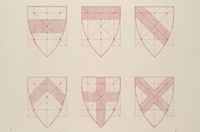Ruskin's revision to the Rudimentary series (1878)
Unpublished manuscript catalogue for proposed re-organisation of the Rudimentary series.

-
 remains
14.
remains
14.
An example of Turner’s early heraldic work. Examine with lens the beautifully legible signature of Oliver Cromwell on the smallest of the fallen papers; also under the helmet the writing of the pedigree of the Farnley family. As brush-work, the sentence they are sometimes, and the perfectly free Hawkesworth and Richmond will give a general idea of the ease of Turner’s hand in minute lines. The colour of the shields on the principal scroll, and the lion rampant on the standard of Fairfax are to be copied by all students as soon as they have attained some facility in water-colour. The lion being executed with a wash of grey over the underlying vermilion bars, and the roughnesses given by only one process of retouching, with a scratch or two of the knife to conquer the vermilion, is of extremest value as a water-colour exercise. The drawing once belonged to M.r. Fawkes of Farnley and had been frightfully R. injured by ill usage on the left hand side of it before it came into my possession.
-
remain
15.-21.
To be used for early pen-practice under M.r. Macdonald’s directions.
-
 remains
22.
remains
22.
Placed here to show the proper treatment of heraldry in sculpture. The building is of three dates: its capitals, and the arches they bear, are Byzantine; the shields and casque, inlaid with modifications of the earlier work, presumably in the Fifteenth Century; the balustrade above barbarous Seventeenth. But nothing could surpass the beauty of the whole when I made this sketch in 1845; the lovely wild weeds being allowed to root themselves in the sculptures. Although I did not in 1845 know how to paint, the extreme fault of this and other drawings of mine at the time are owing to the fact that I was always working, not for the sake of the drawing, but to get accurate knowledge of some point in the building - which knowledge I always expressed securely first with the pen, however hard or bad the effect might be afterwards. Thus here I R. wanted the curves of the shield and casque, and the exact relief and method of their decoration. If you will look with a magnifying-glass at the bit of foliage in the front of the casque and at the door and window of the castle that surmounts it, you will see that the accuracy with which these are drawn was wholly incompatible with picturesque effect unless I had been John Lewis, instead of John Ruskin, and given my life to such work. But the pieces of yellow leafage above are freely and rightly painted, first with Chinese-white and then glazed. The bit of Oxford weed below is well indicated in form, though left too green in colour from mere hurry, and it will do any student good, in early stages of colour-study, to copy this casque with the leaves above and the two shields at each side of it. Of course the rest of the drawing is miserably hurried.
-
removed
23.
An invaluable piece of medieval work, well photographed. Will be variously referred to in The Laws of Fiesole.
-
 removed
24.
removed
24.
Quite invaluable; the monument having been now restored. It is variously referred to in different R. places in my writings.
-
 remains
25.
remains
25.
The comparison of this with No 24, will always be in the highest degree instructive; 25, showing the result of total want of education on an entirely strong and original artistic mind. Had Prout been trained in a fine school he could have done things as beautiful as the monument itself; being left without instruction, this is all he could come to. But this is far better than he could have done had he been ill-instructed. The power of this is true and natural as far as it goes.





